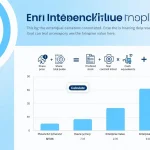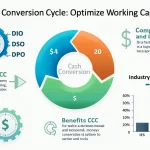Compound Annual Growth Rate Calculator
Is this tool helpful?
How to use the tool
- Beginning Value – type your initial investment, e.g., $3,200 or $9,750.
- Ending Value – add its current worth, such as $5,000 or $13,400.
- Number of Periods (years) – enter the elapsed time, for instance 4 or 8.
- Read the result – the calculator shows the compound annual growth rate as a percentage.
Formula behind the calculator
The tool applies the standard CAGR equation:
$$\text{CAGR}= \left( rac{\text{Ending Value}}{\text{Beginning Value}}\right)^{ rac{1}{\text{Years}}}-1$$
Example calculation A
- Start: $3,200
- Finish: $5,000
- Years: 4
- CAGR = $(5,000/3,200)^{1/4}-1 = 11.8%$
Example calculation B
- Start: $7,500
- Finish: $11,000
- Years: 6
- CAGR = $(11,000/7,500)^{1/6}-1 = 6.6%$
Quick-Facts
- Minimum inputs: positive numbers only; zero or negative values break the formula (MDN Docs, https://developer.mozilla.org).
- S&P 500’s 1928-2022 CAGR ≈ 10 % (Damodaran, 2023).
- CAGR ignores interim cash flows—use IRR if deposits or withdrawals occur (Investopedia, https://www.investopedia.com/terms/i/irr.asp).
- Financial analysts favour CAGR for comparing uneven time spans (Morningstar, https://www.morningstar.com).
FAQ
What does CAGR tell you?
CAGR shows the fixed annual rate that would grow your starting amount to the ending amount over the chosen period, smoothing out volatility (Investopedia, https://www.investopedia.com/terms/c/cagr.asp).
Why not rely on average annual return?
An arithmetic average overstates performance because it ignores compounding; CAGR incorporates compounding, giving a true growth picture (Finance Train, https://financetrain.com).
Can CAGR be negative?
Yes. If the ending value is lower than the beginning value, the ratio inside the formula falls below 1, producing a negative rate that represents shrinkage (Corporate Finance Institute, https://corporatefinanceinstitute.com).
How accurate is CAGR for volatile assets?
CAGR masks year-to-year swings; pairing it with standard deviation or drawdown reveals volatility hidden by the smooth average (Hull, 2022).
When should I use IRR instead?
Use IRR when the investment has multiple inflows or outflows, such as rental property cash streams, because CAGR assumes a single initial outlay (Investopedia, https://www.investopedia.com/terms/i/irr.asp).
How do I project a target value with CAGR?
Rearrange the formula: Target = Beginning × (1 + CAGR)Years. This lets you estimate future balances under a chosen growth rate (Kenton, 2023).
Is CAGR affected by inflation?
No, CAGR is nominal. Subtract the average inflation rate to find the real growth rate (U.S. BLS CPI FAQ, https://www.bls.gov).
What range of years works best?
Three to ten years balances short-term noise and long-term regime changes; analysts often benchmark over 5-year periods (Morningstar Methodology, https://www.morningstar.com).
Important Disclaimer
The calculations, results, and content provided by our tools are not guaranteed to be accurate, complete, or reliable. Users are responsible for verifying and interpreting the results. Our content and tools may contain errors, biases, or inconsistencies. Do not enter personal data, sensitive information, or personally identifiable information in our web forms or tools. Such data entry violates our terms of service and may result in unauthorized disclosure to third parties. We reserve the right to save inputs and outputs from our tools for the purposes of error debugging, bias identification, and performance improvement. External companies providing AI models used in our tools may also save and process data in accordance with their own policies. By using our tools, you consent to this data collection and processing. We reserve the right to limit the usage of our tools based on current usability factors.







